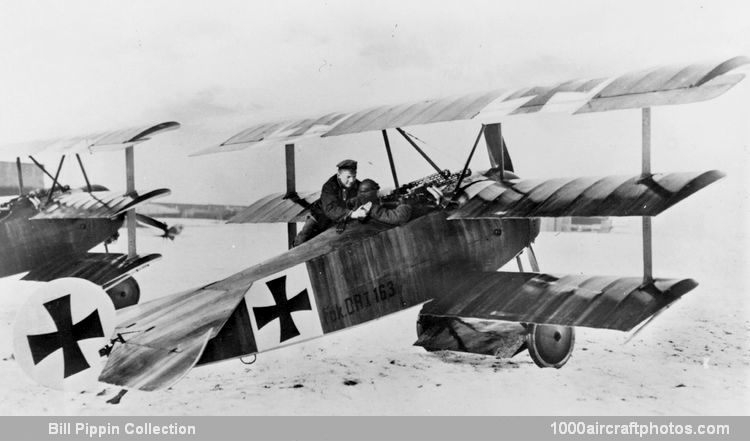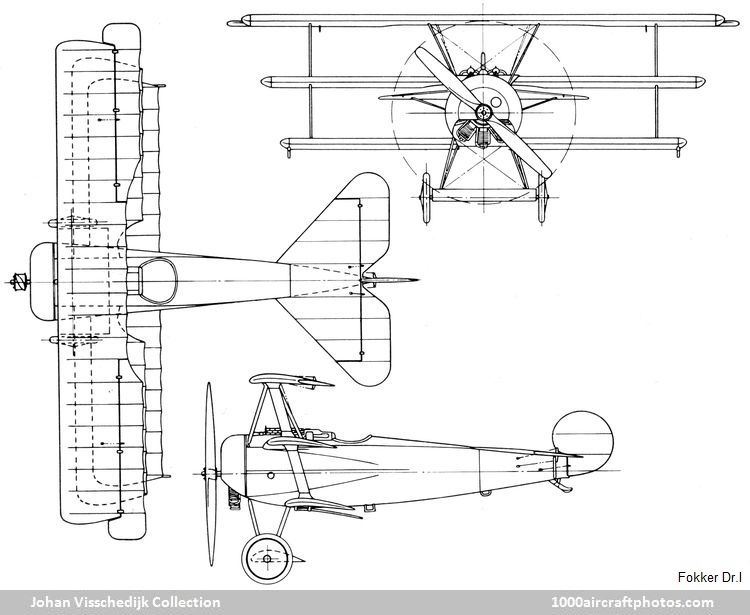11/15/2020. Remarks by Johan Visschedijk: "After initial trials the Fokker V.4 (Versuchsmaschine or experimental plane) received some modifications to improve maneuverability and control, mainly in the addition of overhung balance portions on the ailerons, balancing of the elevators and the simplification of the tail plane shape from near semicircular to a triangular profile. In this guise the aircraft went into production in the summer of 1917; the first examples were designated F.I, but after three machines had been completed the newly instituted military designation Dr.I was applied.
The fuselage and complete empennage followed the earlier successful Fokker formula, utilizing welded steel-tube construction with transverse cable bracing to make a rigid box-girder structure. Power unit was the 110 hp Le Rhône rotary, either license-built by Thulin in Sweden or copied as the Ur II by Oberursel in Germany. A near-circular cowling housed the engine, the flat front plate being fretted with round cooling holes, although some machines had open front cowls similar to those fitted to French Nieuport scouts. The circular-section cowl was faired into the basic slab-sided fuselage by the clipping to the sides of triangular plywood panels which tapered aft as far as the cockpit. A similar plywood panel was attached to the curved decking aft of the cockpit, the whole then being fabric covered.
Of deep section, the cantilever wings were identical in chord and construction and only differed slightly in span. These were built on a single spar which was actually two box-spars, joined together top and bottom with ply, to form a single compound unit of constant cross-section throughout its length. Circular lightening holes were extensively fretted in the plywood ribs and the leading edge was covered with thin plywood sheet extending as far aft as the spar, to which the sheet was tacked. The trailing edge was simply a wire which formed a scalloped profile when the fabric covering was doped. Ailerons were of welded steel tube with overhung balance portions; wing tips were fashioned from rejected ribs and ash tip skids were fitted to the under sides of the lower wings. Quadrant-shaped cut-outs were made at the inboard ends of the middle wing to improve downward vision from the cockpit.
Center sectionand landing gear struts were of streamlined steel tube, and an additional airfoil lifting surface was built over the axles and spreader bars, the wheels being sprung with elastic shock cord. A stout steel-shod ash tailskid was fixed to the rear post, and light steel struts braced the tail plane to the underside of the fuselage.
The Fokker Dr.I entered service in October 1917 and was flown with success by many well-known pilots, including the legendary "Red Baron", Manfred von Richthofen. Although not as fast as contemporary scouts, it was the agility of the Fokker that appealed to the leader of Geschwader 1 (as indeed it did to many other pilots), and once having flown the type, he used it almost exclusively until he was killed on April 21, 1918.
Another famous pilot, Heinrich Gontermann, renowned for his balloon-busting activities, was flying an Dr.I on October 29, 1917 when a fault developed in the wing structure. Gontermann crash-landed the aircraft, as several other Dr.Is had crashed in similar circumstances, the type was temporarily grounded for the wing structure to be strengthened, and it did not resume operations again until the last weeks of 1917. It remained in service until the summer of 1918, but was not widely used outside the Richthofen Geschwader after the beginning of the year. Total production of the type amounted to 320, the last example being completed in May 1918.
The aircraft above was ordered in September 1917, accepted by the German AAS on November 5, and dispatched to the front on December 13, 1917. It went to Jasta 11 and was assigned to Lieutenant von Conta, while Lieutenant Hans-Karl von Linsigen also flew the aircraft. On May 20, 1918 the Dr.I was transferred to Jasta 5."

